Syngonium podophyllum
Syngonium podophyllum is a species of aroid, and commonly cultivated as a houseplant. Common names include: arrowhead plant, arrowhead vine, arrowhead philodendron, goosefoot, African evergreen,[3] and American evergreen.[4] The species is native to a wide region of Latin America from Mexico to Bolivia, and naturalized in the West Indies, Florida, Texas, Hawaii, and other places.[2][5][6][7][8][9][10][11][12][13]
| Syngonium podophyllum | |
|---|---|
 | |
| Syngonium podophyllum var. podophyllum[1] | |
| Scientific classification | |
| Kingdom: | Plantae |
| Clade: | Tracheophytes |
| Clade: | Angiosperms |
| Clade: | Monocots |
| Order: | Alismatales |
| Family: | Araceae |
| Genus: | Syngonium |
| Species: | S. podophyllum |
| Binomial name | |
| Syngonium podophyllum Schott | |
| Synonyms[2] | |
| |
Etymology
Syngonium podophyllum is the most commonly cultivated species in the genus Syngonium, and is often referred to simply as syngonium. It was originally confused with the similar-looking African genus Nephthytis, and this is still used as a common name for the plant. It was given its own genus in 1879.[14]
The Latin specific epithet podophyllum means “with stout-stalked leaves”.[15]
Description
It climbs a few meters tall over the trunks of tropical jungle trees, clinging to their roots. The cultivars cultivated indoors reach a height of up to 1.5 m. During the year, the plant grows about 30 cm and produces 6-7 leaves. Its single, long-legged leaves, usually arrow-shaped, are up to 30 cm long. In wild, the leaves are dark green and without variegation. Cultivated varieties have leaves in various shades of green, often light green and usually with different types of lighter tannins. There are several variegated cultivars, the main differences being in the position and extent of the cream or white markings. Some leaves are almost entirely white, pink or yellow.
Its flowers are small, greenish, collected in a flask, covered with a purple-red scabbard. However, the plants grown indoors do not bloom, aside from the older, well-cared-for specimens.
Cultivation
As a creeper, it needs some support. It can also be grown as a groundcover plant. The soil should be humus and systematically watered. Varieties with bright leaves with dyes need a well-lit place, though those with dark green leaves can grow in a darker place. The summer temperature should not exceed 24°C, in winter it should not be lower than 15 ° C. Requiring moist air, it should be watered 2-3 times a week in summer, but much less often in winter.
To ensure adequate humidity, the plant pot should be placed in a larger container with constantly moist peat and sprayed with water daily. Dusty leaves are to be wiped with a damp cloth. Feed in the summer with a small dose of fertilizers dissolved in water. After a few years of cultivation, the plant becomes unattractive, where it cutting is advisable, then it will release new shoots. It should be transplanted only when necessary.[16]
It has gained the Royal Horticultural Society’s Award of Garden Merit.[17][18]
Propagation
The plant can be propagated by cuttings in water, or straight into potting compost. Nonetheless, both methods have a good success rate, providing the right part of the plant is cut. Cuttings using the rooting machine are rooted in a multiplier at a temperature of 18°C. Seedlings from the tops of the shoots are the easiest for sprouting, the hardest from the bottom part of the stem.[19]
Toxicity
All parts of the plant are poisonous and cause severe mouth pain if eaten.[20] It is not unusual to find these growing in Sub-tropical Florida landscapes, where homeowners and Gardeners need to be aware of the severe skin burning sensations caused by the plants sap containing oxalic acid and the eye damage potential from raphides.[21]
Varieties
Among the wild populations, two varieties are formally recognized:[2][22]
- Syngonium podophyllum var. peliocladum (Schott) Croat - Costa Rica, Panama
- Syngonium podophyllum var. podophyllum - widespread as a native from Mexico to Brazil and Bolivia, as well as Trinidad; naturalized in the West Indies (including the Cayman Islands and the Bahamas), Florida, Texas, Hawaii, Seychelles, Borneo, and Malaysia
Gallery




References
- Adolf Engler - Das Pflanzenreich vol. 71 (1920)
- Kew World Checklist of Selected Plant Families
- http://www.desert-tropicals.com/Plants/Araceae/Syngonium_podophyllum.html
- "Syngonium podophyllum". Natural Resources Conservation Service PLANTS Database. USDA. Retrieved 7 December 2015.
- Govaerts, R. & Frodin, D.G. (2002). World Checklist and Bibliography of Araceae (and Acoraceae): 1-560. The Board of Trustees of the Royal Botanic Gardens, Kew.
- Hammel, B.E. & al. (2003). Manual de Plantas de Costa Rica 2: 1-694. Missouri Botanical Garden Press, St. Louis.
- Acevedo-Rodríguez, P. & Strong, M.T. (2005). Monocotyledons and Gymnosperms of Puerto Rico and the Virgin Islands. Contributions from the United States National Herbarium 52: 1-415.
- Hernandez, J. (2007). In Hawaiian rainforests: exotic aroid ecologies. Aroideana 30: 91-97.
- Nelson Sutherland, C.H. (2008). Catálogo de las plantes vasculares de Honduras. Espermatofitas: 1-1576. SERNA/Guaymuras, Tegucigalpa, Honduras.
- Hokche, O., Berry, P.E. & Huber, O. (eds.) (2008). Nuevo Catálogo de la Flora Vascular de Venezuela: 1-859. Fundación Instituto Botánico de Venezuela.
- Arruda Pontes, T., Moreira de Andrade, I. & Alves, M. (2010). Flora da Usina São José, Igarassu, Pernambuco: Araceae. Rodriguésia; Revista do Instituto de Biologia Vegetal, Jardim Botânico e Estaçao Biologica do Itatiaya 61: 689-794.
- Oppenheimer, H. (2011). New Hawaiian plant records for 2009. Bishop Museum Occasional Papers 220: 5-10.
- Acevedo-Rodríguez, P. & Strong, M.T. (2012). Catalogue of seed plants of the West Indies. Smithsonian Contributions to Botany 98: 1-1192.
- http://www.arhomeandgarden.org/plantoftheweek/articles/Arrowhead_Philodendron.htm
- Harrison, Lorraine (2012). RHS Latin for Gardeners. United Kingdom: Mitchell Beazley. ISBN 184533731X.
- Dawid Longman: Nurturing house plants . Warsaw: Państwowe Wydawnictwo Rolnicze i Leśne, 1997. ISBN 83-09-01559-3 .
- "RHS Plantfinder - Syngonium podophyllum". Retrieved 30 November 2018.
- "AGM Plants - Ornamental" (PDF). Royal Horticultural Society. July 2017. p. 100. Retrieved 30 November 2018.
- Roskov Y., Kunze T., Orrell T., Abucay L., Paglinawan L., Culham A., Bailly N., Kirk P., Bourgoin T., Baillargeon G., Decock W., De Wever A., Didžiulis V. (ed) (2014).
- http://www.ces.ncsu.edu/depts/hort/consumer/poison/Syngopo.htm
- "University of Florida advisory Poisonous Garden Plants" (PDF).
- Biota of North America Program, 2013 county distribution map